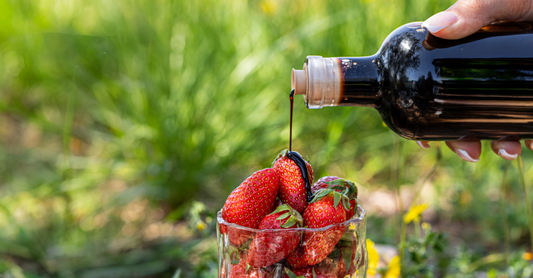Balsamic vinegar is a quality product originating from the Modena region of Italy. Prized in gourmet cuisine for its robustness, smoothness, and distinctive aroma, it is a key ingredient in Mediterranean cuisine. Traditionally, it is made from a mixture of concentrated grape juice, vinegar, and caramel, then aged in wooden barrels for several years. This aging process gives balsamic vinegar its dark color, thick texture, and sweet-tangy flavor.
The expiration date of balsamic vinegar
Balsamic vinegar , a refined condiment of Italian gastronomy , does not expire in the classic sense, thanks to its high acidity which prevents the proliferation of bacteria and mold. However, its texture, color, smell and flavor can change over time. To maintain its authenticity and properties, proper storage is essential. It should be kept away from light, in a cool, dark place to preserve its quality and aroma. Thus, used in your recipes or as a marinade, it will bring a touch of sweetness and refinement to your dishes.
Use and storage of balsamic vinegar
When properly stored, balsamic vinegar can retain its flavor and aroma for many years. It's important to note that once the bottle is opened, the vinegar should be used within a few years. For tasting, it can be used in a variety of recipes, from cooking and tasting to salad dressings and marinades. From a health perspective, this organic and vegan product has significant antioxidant power, which contributes to a healthy diet.
Factors influencing the shelf life of balsamic vinegar
Balsamic vinegar , a staple of Italian cuisine originating from Modena , can be stored for years without spoiling. However, several factors can influence its shelf life . Product quality, storage conditions, taste, texture, color, and smell are all elements that can change and indicate a loss of freshness.
The impact of balsamic vinegar quality on its sustainability
The quality of balsamic vinegar is a determining factor in its durability. A traditional, artisanal product, produced through careful aging and distillation, generally exhibits greater robustness and sweetness, as well as a richer aroma. These components are more resistant to time and changes in storage conditions. Furthermore, high-quality balsamic vinegars contain antioxidants , which help preserve their freshness and prevent mold growth. It's also worth noting that balsamic vinegar, as a vegan and often organic ingredient, does not contain components that can degrade quickly, which enhances its longevity.
Influence of storage conditions on the durability of balsamic vinegar
Storage conditions have a direct impact on the shelf life of balsamic vinegar. Once opened, it is recommended to store the bottle in a cool, dark place away from direct light and heat. Refrigeration is not necessary, but it can help preserve the flavor and texture of the product. It is also important to reseal the package tightly after each use to prevent air from entering, which can alter the taste and color of the vinegar. By following these storage guidelines, balsamic vinegar can retain its sensory qualities for several years, while ensuring optimal food safety.
How do you know if your balsamic vinegar is still good?
Balsamic vinegar is a robust product that, thanks to its acidity and antioxidant power, can be stored for a long time. Originating from the Modena region of Italy, this condiment is a staple of Italian and Mediterranean cuisine. While it doesn't perish in the traditional sense, its quality can still deteriorate over time. Changes in its color, odor, and texture can indicate a decrease in its freshness and quality. It's worth noting that proper storage is essential to maintain the integrity of this precious product. For optimal preservation, balsamic vinegar should be kept in a tightly closed bottle, away from light and heat.
Visual and olfactory signs of balsamic vinegar degradation
Visual signs of spoiled balsamic vinegar include changes in its color and texture. A quality balsamic vinegar should have a rich, deep color, ranging from dark brown to black. If its color appears washed out or has a reddish tint, this may indicate spoilage. Texture-wise, a good-quality balsamic vinegar will be thick and sticky. If the vinegar appears watery or shows signs of mold, this may also indicate that it is no longer as fresh as it should be. Additionally, a sour odor, unlike the typical sweet and sour aroma of balsamic vinegar, may also signal deteriorating quality.
Taste test to confirm the quality of the balsamic vinegar
Taste is another important indicator of balsamic vinegar quality. A good quality balsamic vinegar will have a perfect balance of acidity and sweetness, with notes of fruit, caramel, and wood. If the vinegar tastes sour or metallic, or if its sweetness and acidity are unbalanced, this may indicate a decline in quality. Regular tasting can help identify changes in taste over time. It is recommended to taste the vinegar before using it in your cooking recipes to ensure it will deliver the desired flavors.
Balsamic vinegar , a product originating from Modena, Italy, is a treasured ingredient in Mediterranean cuisine, especially fine dining. With its robust aroma and distinctive sweetness, it adds a unique flavor to recipes. Yet, many wonder: can balsamic vinegar go bad?
How to Use Balsamic Vinegar for Maximum Longevity
In reality, balsamic vinegar doesn't expire in the traditional sense. Its shelf life is virtually unlimited, thanks to its natural acidity, which prevents mold growth. Possible changes in taste, texture, color, and odor are generally the result of improper storage rather than expiration. However, its quality can diminish over time. This is why proper storage of balsamic vinegar is essential to preserve its freshness, flavor, and quality.
Tips for storing balsamic vinegar
To best preserve balsamic vinegar, it is recommended to store it in a cool, dark place, ideally in a tightly sealed bottle. It does not need to be refrigerated. Avoid storing it near heat sources such as the oven or stove, as heat can alter its flavor. Additionally, it is best to use balsamic vinegar within six months of opening the bottle for optimal quality. Finally, for food safety, always use clean utensils when handling balsamic vinegar to avoid contamination.







 lucangeli.it
lucangeli.it